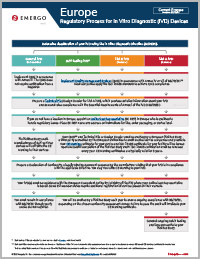European IVD Regulatory Approval Process

有任何问题?向我们的专家获取相关信息
联系我们IVD devices (In Vitro Diagnostics) are a subset of medical devices primarily used for to testing human fluids such as blood, tissue or urine in a test tube. This may include reagents, instruments and specimen receptacles. In Europe, the In-Vitro Diagnostic Devices Directive (98/79/EC) is used to regulate IVDs. For more information download the chart below.
The IVD CE Marking approval process in Europe
The chart shown illustrates the CE approval process for In Vitro Diagnostics (IVDs) in Europe and is available for download in PDF format. However, if you would like to explain the steps to someone else in an email, you can cut and paste the text below or send them a link to this page.
Step 1
Determine classification of your device using the In Vitro Diagnostic Directive (98/79/EC): General IVD (Self-certified), Self-Testing IVD*, List B IVD (Annex II), List A IVD (Annex II)
Step 2
For the General IVD (Self-certified) class, a QMS is not formally required.
For all other IVD classes, implement Quality Management System (QMS) in accordance with Annex IV or VII of 98/79/EC.
Most companies apply the ISO 13485 standard to achieve QMS compliance.
Step 3
For all classes, (Design Dossier for List A IVD), which provides detailed information about your IVD and demonstrates compliance with the Essential Requirements of Annex I of the IVD D 98/79/EC.
Step 4
Appoint an Authorized Representative (EC Rep) located in Europe who is qualified to handle regulatory issues. Place EC REP name and address on Instructions for Use, outer packaging, or device label.
Step 5
For General IVD (Self-certified), no Notified Body audit. Manufacturers of Self-Certified devices will self-affix the CE Marking to their devices.
For all other classes, your QMS and Technical File must be audited by a European Notified Body, a third party accredited by the European authorities to audit medical device companies and products. Your CE Marking certificate for your device will be issued upon successful completion of the Notified Body audit.
Step 6
For all classes, prepare a Declaration of Conformity, a legally binding document prepared by the manufacturer stating that your IVD is in compliance with the applicable Directive. You may now affix CE Marking to your IVD.
Step 7
Your IVD(s) must be registered with the European Competent Authority (Ministry of Health) where your Authorized Representative is based. Some EU member states require additional registration of devices placed on their markets.
Step 8
For the General IVD (Self-certified) class, the self-certified CE Marking certificate does not expire as long as you remain in compliance with 98/79/EC.
For all other classes, you will be audited by a Notified Body each year to ensure ongoing compliance with 98/79/EC. Failure to pass the audit will invalidate your CE Marking certificate.
Step 9
For List A IVD (Annex II), conduct ongoing batch testing and forward results to your Notified Body.
* Self-testing IVDs exclude devices that are included in Annex II, List A and List B.
This is a simplified overview of the process. Your Notified Body may choose to audit your submission and request more documents, which will add time to your approval.
Chart updated: 21/02/2017
相关
-
了解欧盟新的医疗器械法规 - MDR 2017/745
您可能已经听说,欧盟完善的医疗器械法规即将迎来变化。并且您可能有很多疑问。这些变化意味着什么,它们将如何影响您的公司? 欧盟新的医疗器械法规(MDR)将对医疗器械制造商进入欧盟市场的方式以及如何在产品的整个生命周期内维持合规产生重大影响。在这份长达28页的白皮书中,Emergo的
阅读更多 -
墨西哥的COFEPRIS医疗器械注册
阅读更多